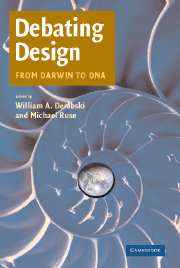Book contents
- Frontmatter
- Contents
- Notes on Contributors
- Debating Design
- INTRODUCTION
- PART I DARWINISM
- PART II COMPLEX SELF-ORGANIZATION
- PART III THEISTIC EVOLUTION
- 12 Darwin, Design, and Divine Providence
- 13 The Inbuilt Potentiality of Creation
- 14 Theistic Evolution
- 15 Intelligent Design
- 16 The Argument from Laws of Nature Reassessed
- PART IV INTELLIGENT DESIGN
- Index
15 - Intelligent Design
Some Geological, Historical, and Theological Questions
Published online by Cambridge University Press: 05 June 2012
- Frontmatter
- Contents
- Notes on Contributors
- Debating Design
- INTRODUCTION
- PART I DARWINISM
- PART II COMPLEX SELF-ORGANIZATION
- PART III THEISTIC EVOLUTION
- 12 Darwin, Design, and Divine Providence
- 13 The Inbuilt Potentiality of Creation
- 14 Theistic Evolution
- 15 Intelligent Design
- 16 The Argument from Laws of Nature Reassessed
- PART IV INTELLIGENT DESIGN
- Index
Summary
The design argument evokes William Paley walking on a Cumbrian moorland and discovering a watch. In the windswept silence, he developed his watchmaker analogy of an intelligent designer, and thus Intelligent Design may be considered as the restatement of the old argument refuted by Charles Darwin. There are similarities but also important differences between the old design arguments of Paley, William Buckland, and even John Ray and those of Behe, Dembski, and other proponents of Intelligent Design. In order to make a valid comparison, it is essential to consider the content and context of design, old and new, and the relationship of both to geological time, biological evolution, naturalism (or secondary causes), and a “theological approach” to science. My first major concern is the refusal of design theorists to take sufficient cognisance of the vastness of geological time. Second, I show that, historically, scientists cannot simply be typecast as “theistic” or “naturalist,” as both some design theorists and some critics imply. Third, I show that Intelligent Design is more an argument from rhetoric than from science, and finally I seek to demonstrate the difference between Intelligent Design and the nineteenth-century design arguments and to show how Intelligent Design is very different from Paley's argument.
Design arguments came to prominence in the seventeenth-century, evolving from theological arguments of “nature leading to nature's God” in a culture dominated by mechanistic science.
- Type
- Chapter
- Information
- Debating DesignFrom Darwin to DNA, pp. 275 - 293Publisher: Cambridge University PressPrint publication year: 2004
- 2
- Cited by



